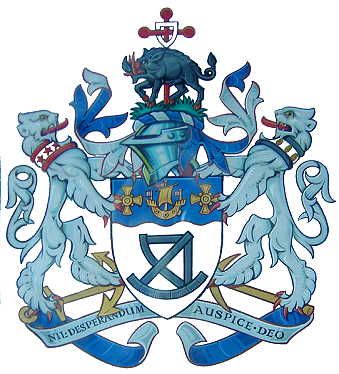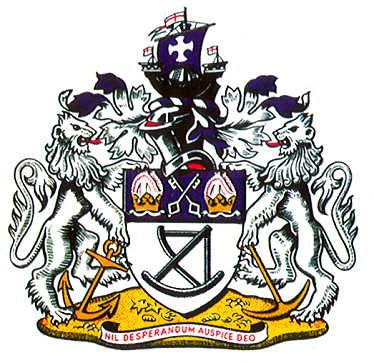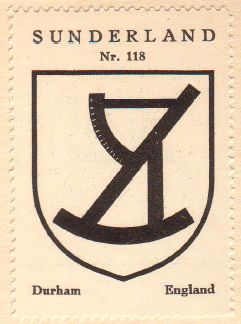Sunderland: Difference between revisions
Knorrepoes (talk | contribs) m (Text replacement - "====Official blazon====" to "===Official blazon===") |
Knorrepoes (talk | contribs) m (Text replacement - "====Origin/meaning====" to "===Origin/meaning===") |
||
| Line 19: | Line 19: | ||
'''Motto''' : 'NIL DESPERANDUM AUSPICE DEO' - With God as our leader there is no cause for despair. | '''Motto''' : 'NIL DESPERANDUM AUSPICE DEO' - With God as our leader there is no cause for despair. | ||
===Origin/meaning=== | |||
The arms were officially granted in 1992 (?) | The arms were officially granted in 1992 (?) | ||
| Line 42: | Line 42: | ||
'''Motto''' : 'NIL DESPERANDUM AUSPICE DEO' - With God as our leader there is no cause for despair. | '''Motto''' : 'NIL DESPERANDUM AUSPICE DEO' - With God as our leader there is no cause for despair. | ||
===Origin/meaning=== | |||
The arms were officially granted on ?? | The arms were officially granted on ?? | ||
| Line 64: | Line 64: | ||
'''Motto''' : 'NIL DESPERANDUM AUSPICE DEO' - With God as our leader there is no cause for despair. | '''Motto''' : 'NIL DESPERANDUM AUSPICE DEO' - With God as our leader there is no cause for despair. | ||
===Origin/meaning=== | |||
The arms were officially granted on August 10, 1949. | The arms were officially granted on August 10, 1949. | ||
Revision as of 10:18, 23 June 2017
| Heraldry of the World Civic heraldry of the United Kingdom |
SUNDERLAND
City Council
City status granted in 1992. Direct successor of the Metropolitan Borough of Sunderland.
Official blazon
Arms : Azure between in chief and in base a Bar wavy Argent charged with a like Barrulet Azure a Crown flory Or the circlet charged with four Saltires couped Gules.
Crest : On a Wreath Or and Azure upon Water barry wavy Azure Argent Azure a Lymphad with Oars in action proper each Castle charged with two Crosses of Saint Cuthbert (one manifest) Or a Sail of the Arms pennon and flags Gules; Mantled Azure doubled Or.
Supporters : On the dexter side a Lion Or amrned and languled Gules gorged with a Collar Argent fimbriated Sable charged with six Ears of Wheat proper (three manifest) dependent therefrom a Roundel per bend wavy Or and Azure charged with a Cross pommy Gules entwined by an Orle Argent standing on an Anchor the flukes inward Or and on the sinister side a Lion Azure amrned and languled Gules gorged with a Collar Argent fimbriated Gules charged with six Mullets also Gules (three manifest) dependent therefrom a Roundel per bend wavy Or and Azure charged with a Boar's Head close couped Gules armed Or standing on a Miner's Pick ward Or the head turned inwards also Gold.
Motto : 'NIL DESPERANDUM AUSPICE DEO' - With God as our leader there is no cause for despair.
Origin/meaning
The arms were officially granted in 1992 (?)
The blue and white waves refer to the River Wear and maritime activities. The crown is a royal emblem and the four saltires, like the Roman numeral X, supposedly each represents ten years of Queen Elizabeth's reign. However, in the definitive painting, on the Letters Patent, the each crown has two and two half-saltires visible. Usually this implies another two and two half-saltires on the invisible half of the circlet. When used by the Council the crowns have four full saltires visible.
The ancient ship, returned to the same position as in the crest of the County Borough of Sunderland (see below), alludes to the shipping traffic of the district, and the crosses are those of St Cuthbert, patron saint of the County of Durham.
The lions are based on the supporters of the former arms, with a change in colour. The collar of the left lion represents Hetton. Its twin collar is black and represents the railway laid down by George Stephenson to carry Hetton's coal to the Wear. Between the 'rails' are three ears of wheat, representing Hetton's agricultural interests and those of Burdon and Warden Law. The red cross pommy is the ancient symbol of St. Michael, the patron Saint of Houghton-le-Spring's Church and parish. The white orle, entwined with the cross is from the arms of the ancient Le Spring family, Norman lords of the manor. The collar of the right lion with three red stars, is taken from the stars and stripes of the Washington family. The boar's head is derived from the device of Houghton-le-Spring UDC. All these emblems formed part of the arms of the former Metropolitan Borough arms in varying positions. The gold anchor and pick are for the two main local industries, as in the two former Sunderland arms.
The motto has traditionally been used by Sunderland Borough, see below.
Metropolitan Borough
Additions : 1974 Chester-le-Street RDC (partly) ,Easington RDC (partly), Hetton UDC, Houghton-le-Spring (UDC), Sunderland Borough, Washington UDC
Official blazon
Arms : Argent a Quadrant Sable on a Chief wavy Azure between two Crosses of St. Cuthbert an Ancient Ship sail set Or flying Flags and Pennon of St. George.
Crest : On a Wreath Argent and Azure on a Mount Vert in front of a Long Cross pommy issuant Gules the head interlaced with an Orle Argent a Boar passant Sable armed and langued Gules.
Supporters : On either side a Lion Argent that on the dexter gorged with a Collar gemel enclosing six Mullets three being manifest Gules and standing on an Anchor fesswise the flukes inward Or that on the sinister gorged with a Collar gemel Sable enclosing six Ears of Wheat three being manifest proper standing on a Miner's Pick fesswise the head inward Or.
Motto : 'NIL DESPERANDUM AUSPICE DEO' - With God as our leader there is no cause for despair.
Origin/meaning
The arms were officially granted on ??
The shield is based on that of the former County Borough of Sunderland and contains the familiar quadrant or sextant (as it is sometimes desribed) on its white field. The wavy edge of the blue chief suggests the River Wear and the gold ship is from the former Sunderland crest. The two flanking gold crosses of St. Cuthbert represent Sunderland's historic connections with the bishops and monks of Durham.
The crest is derived from the device of Houghton-le-Spring UDC, in which was a 'boar passant'. This was the crest of Bernard Gilpin, Rector of Houghton. The black boar stands on a grassy mound in which is fixed a long 'cross pommy' - a cross with apple-like knobs on the apex and arms in red. This is the ancient symbol of St. Michael, the patron Saint of Gilpin's Church and parish, one of the most important in Durham in his time. The white 'orle', or hollow shield, entwined with the cross is from the arms of the ancient Le Spring family, Norman lords of the manor.
The supporters are the white lions of the former Sunderland arms, derived from the lions of the See and Monastery of Durham. That on the left has a twin collar of red with three red stars, taken from the stars and stripes of the Washington family. That on the right represents Hetton. Its twin collar is black and represents the railway laid down by George Stephenson to carry Hetton's coal to the Wear. Between the 'rails' are three ears of wheat, representing Hetton's agricultural interests and those of Burdon and Warden Law. The gold anchor and pick are for the two main local industries, in the former Sunderland arms the lions supported these emblems, here they have been made a base for the lions to stand on.
The motto has traditionally been used by Sunderland Borough, see below.
County Borough
Incorporated into : 1974 Sunderland metropolitan Borough
Official blazon
Arms : Argent a Sextant Sable on a Chief Azure two Keys wards upwards and outwards in saltire Argent between as many Mitres of the last both enfiled with a Ducal Coronet Or.
Crest : On a Wreath Argent and Azure a Lymphad Sable the Sail Azure charged with the Cross of St. Cuthbert flags flying Argent charged with a cross Gules.
Motto : 'NIL DESPERANDUM AUSPICE DEO' - With God as our leader there is no cause for despair.
Origin/meaning
The arms were officially granted on August 10, 1949.
The sextant formed part of an earlier device of the Corporation. The keys represent Monkwearmouth, as St Peter was the patron of the church attached to the monastery founded by Benedict Biscop in 674. Bishopwearmouth is represented by the mitres, which are encircled by coronets - a distinction enjoyed only by the Bishops of Durham as former Palatinate lords. These emblems together therefore, refer to the early ecclesiastical history of the Borough.
The ancient ship is coloured black in allusion to the coal traffic of the district, and the crosses on the sail and flags are respectively those of St Cuthbert, patron saint of the County of Durham, and St George of England.
The supporting white lions are from the arms of the See of Durham, and the anchor and pick are tokens of Sunderland's principal industries, coloured gold for the prosperity they bring.
The motto is adapted from Horace.
| The arms as used on a JaJa postcard +/- 1905 |
The arms in the Coffee Hag albums +/- 1925 |
Contact and Support
Partners:
Your logo here ?
Contact us
© since 1995, Heraldry of the World, Ralf Hartemink 
Index of the site
Literature : Image and information from here














